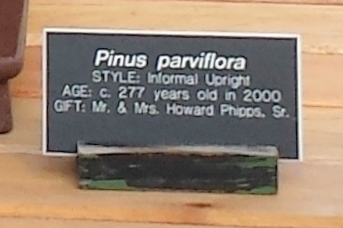One day during my recent visit to New York, my friend and I walked through the Brooklyn Botanical Garden. Early March is not the best time to see this Botanical Garden. The day was cold, and the wind blew. Most of the trees and plants were dead or dormant. The only blooms we saw outside the greenhouses were crocuses, though there were many fields carpeted in the low-slung purple blossoms.
Inside the greenhouses tropical plants thrived. We shed our multiple layers of coats to walk through a rainforest. Our glasses fogged as we strolled past banana trees and ferns and yellow crane flowers and another bright red flower, the name of which I have forgotten.

 In another greenhouse—this one open to the air, though sheltered from the wind—the bonsai trees stood peacefully, as some of them had for centuries. The tag beside one tree said that it was about 277 years old in 2000 when the Botanical Gardens acquired it.
In another greenhouse—this one open to the air, though sheltered from the wind—the bonsai trees stood peacefully, as some of them had for centuries. The tag beside one tree said that it was about 277 years old in 2000 when the Botanical Gardens acquired it.
Think of that—a tree that dates back to 1723. That year, Friedrich Handel and Johann Sebastian Bach were writing their beautiful music. Voltaire was alive (he got smallpox in 1723). The early economist Adam Smith was born, and the architect/astronomer Christopher Wren died.
It was before the American Revolution. In 1723, Benjamin Franklin, age 17, ran away from his home in Boston to Philadelphia, and almost immediately went to London.
Only one branch of my ancestors had made it to America by 1723—the first of my Hooker forefathers, Joseph Hooker, emigrated from England to Massachusetts in 1689. He lived until 1753, so he was alive when this tree sprouted. His grandson John Hooker (also my ancestor) was born in 1722, just about the time this bonsai began.
The bonsai stood in its rock bed for more than a century before the events described in my novel of 1847 took place—the shooting of a cannon from the top of Independence Rock and the massacre of the Whitmans in Oregon. The tree was more than 200 years old when my parents were born in 1933. It is now closing in on its 300th birthday.
I have been impressed by the age of human edifices—the Roman Forum and the ruins of Pompeii. I have been impressed by huge natural wonders formed over time—the Grand Canyon, the Rocky Mountains. But a tree? Other than a few redwoods, I’ve rarely been impressed by the history of a tree.
The text describing the bonsai exhibit said:
“Bonsai is sometimes misconstrued as an exercise in restricting growth. Trees are mistakenly valued only for age, rather than for how they capture a moment in nature.”
For me, this bonsai tree captured not only a moment in nature but the passage of time. I thought of all that has happened in human history during its lifespan.
As I continue to reflect on this bonsai, I also contemplate my own lifespan. I wonder what legacy I will leave behind. Will someone someday reflect on my life as I reflect on my ancestors coming to a New World, on the emigrants to Oregon, and on the miracles of music and invention that have been created in the last 300 years?
And I also admire a Japanese potter who nourished this bonsai three centuries ago and who brought me to these moments of contemplation.
When have you viewed something old and been in awe of its history?




I’m in awe right now…that tree is incredible. I’ve always loved bonsai trees.
This is reminding me of words attributed to a Chinese proverb: The best time to plant a tree was 20 years ago (or, maybe 277 years ago….). The second best time is now.
I’m in awe of something old when I look in the mirror. =)